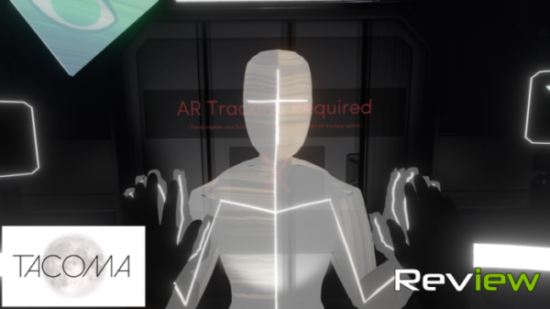ve always been terrified of space. To me, it represents terrifying isolation, perpetual danger and utter loneliness. Being millions and millions and millions of miles away from everything and everyone I care about is a nightmare scenario, a true horror. And in games, it often is — but Tacoma is one that subverts these ideas to paint space as something hopeful, even in its quietude and potential catastrophes. That’s a difficult task, and one that it doesn’t always succeed at, but it’s an often admirable one all the same.
With its follow-up to Gone Home, a breakthrough for the narrative indie game genre, Fullbright returns to familiar thematic territory. But where Gone Home was a quiet individual’s journey, Tacoma is that of several people, and much chattier, even livelier, for it. It’s not just a single short, contained story; it’s multiple concurrent ones. More than just stories, though, Tacoma is about perspectives — and this is where I found the game both fascinating and flawed.
The overarching plot is set in the year 2088, as a space contractor named Amy is sent to investigate the abandoned space station Tacoma. The utter emptiness of the place would be disquieting, were it not for Amy’s task: Comb through the various sections of Tacoma, recovering data and reconstructing what led to its crew taking their leave. With help from some futuristic space technology, Amy is able to literally retrace the steps taken and conversations had by the long-gone team, ranging from anywhere between 10 hours ago and a year prior; she’s a voyeur looking in a not-too-distant past.
This premise means there’s not as much silence as one would expect from a vacant space station. There’s plenty of chatter to be heard from the recreated wireframe Tacoma staffers who wander the halls and the AI system that worked with them, as well as the occasional squeaks from Amy’s own artificial companion. And all of this dialogue makes up the core gameplay of Tacoma — it’s how the story unfolds, with conversations happening at once, all over the place. Amy’s tech allows her to rewind and replay crucial moments from different angles, cobbling together a full picture of how and why the crew left. Some of them are incomplete; others are perhaps inscrutable. But each one helps to reconstruct the station’s history.
This is the game’s deepest mechanic, but it can be an obtuse one. As I wandered through Tacoma, I had a vague sense of where to go, who to talk to, what information I needed to pick up. My interactions — if we can call them that — with the crew were at first purpose-driven, not introspective. I tuned into the first crew member I saw to get a sense of what events caused them all to vacate the station, and then trudged along into another room. When two crew members talked, I listened for the hints of what I needed to know about the station, vagaries that were often buried between other comments.
But Tacoma works best when experienced as a story, not a plot. Rewinding and re-evaluating every scene is key, as it can transform the game from a straightforward question-and-answer experience to a more intriguingly ambiguous one. At certain points in each scene, the option to read over a selection of a character’s personal files comes up. These fill in the backstories for the crew’s strange comments, deep sighs or sudden anxieties in their external dialogue. If I found the dialogue to be puzzling or dull, I could trust that a chat log or an email that I had the chance to look at later on in the scene would be of much more use to me in terms of really engaging with the crew’s plight.
It’s imperative to explore the background information instead of just homing in on the rich, omnipresent conversation scenes — however, this was never made explicitly clear. Amy’s ability to rewind scenarios manifests as a playback bar at the bottom of the screen. Through color-coded pop-ups, this bar indicates who to look for and when; that’s how I knew I could open up the characters’ augmented reality desktops and start reading through them. Yet it was just as easy for me to carry on through a scene without ever attending to these small context clues as it was to rewind a scene all the way to the beginning, just to see it from another point of view. I often felt like one character’s storyline was satisfying enough for me to feel ready to move on from an area.
To ignore these pop-ups is to miss out on the real meat of the game. But it could sometimes be a chore to locate who those pop-ups were pointing to, especially when some lengthy cutscenes ended up divulging such little info. The game’s constrained setting, mixed with a limited amount of sights to see, meant that cutscenes aside, there wasn’t always much I had a strong desire to check out.
There were plenty of bathrooms to interact with, along with the occasional gym locker and under-bed drawer, but not a ton else when it came to character building. The colorful pop-ups make all the difference, though, as they almost invisibly deepen an otherwise simple plot. It’s possible to return to them, and some of them are impossible to miss. But I didn’t always want to catch them all during my first lap around an area, and so I’d later find out that I didn’t learn as much about a situation as I thought I did.
Even when I took the time to read the notes and files that corresponded with every pop-up, though, I didn’t always feel that I had a more complete story. Tacoma is a game that kept me at arm’s length — I had to chip away at those files, characters’ personal quarters and even their slightest movements to eke out the bits that could emotionally engage me. This took some time, and it only sometimes paid off.
Pop-up-denoted intimate moments for some characters left strong impressions: I listened in on the crew’s botanist, for example, as he talked on the phone with his son in a memorable scene. That call became even more impactful when I gained access to his mementos, which included a family photo and an email about why he couldn’t quit his risky job at the Tacoma station.
Every member of the wonderfully diverse cast — racially, ethnically and in terms of sexual orientation — contributed something unique to the story, and it’s those details that stayed with me. But not every moment was so affecting; many characters’ logs remained ambiguous and hardly resonated.
As I unknowingly approached Tacoma’s ending, I found myself in want of more payoff for everyone, and in all respects. The game bucked the shocking space-set conclusion for something more uplifting, yet the ending came at a time when I felt I still wanted to invest in the characters. I still wasn’t quite rooting for them by the time their stories ended, although I hoped that I would. I just never got the amount of time that I wanted in order to do so, as the conclusion barreled toward me, wrapping up the most obvious loose ends.
As in other narrative adventure games, I expected that my desire to understand Tacoma’s characters better would be satisfied with another, even more detail-oriented playthrough. The Tacoma station only offers so much to look at and sift through, however. The finer details could often be worth revisiting, but these came few and far between. Quiet moments moved me most, not the dialogue-heavy ones that make up much more of the game.
WRAP-UP
I continue to think of Tacoma as a story first, but it’s more than that, clearly: It’s an interactive experience, and that plays for and against it. The story is built out of the playback mechanic, which gives birth to the subtler suggestions of what’s really going on with this station. But the playback system means there’s a lot of talking to listen to, and a lot of wireframes to stare at. For a game about an abandoned space station, Tacoma gave me plenty of company. But the moments where I had to reckon with being alone in space were the ones that stuck with me.
Tacoma was reviewed using a pre-release Steam key provided by Fullbright. You can find additional information about Polygon’s ethics policy here.


